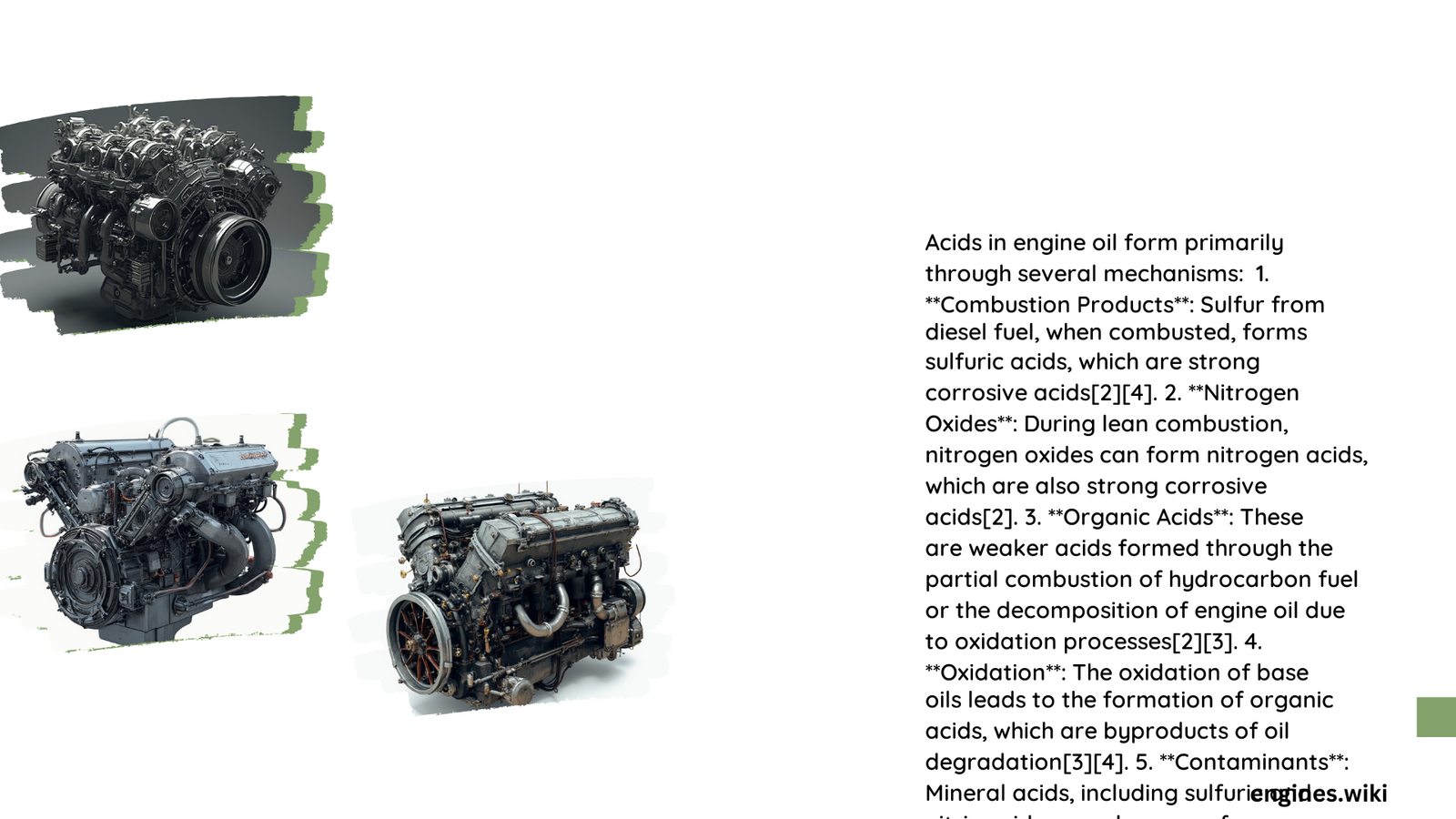Acid formation in engine oil is a complex process influenced by fuel combustion byproducts, oxidation, and contamination. These factors contribute to the production of various acids, including carboxylic acids, sulfur-based acids, and mineral acids. Understanding the mechanisms behind acid formation is crucial for maintaining engine health and optimizing oil performance.
What Are the Primary Sources of Acid Formation in Engine Oil?
Fuel Combustion Byproducts
Fuel combustion is a significant contributor to acid formation in engine oil. During engine operation, the following processes occur:
- ‘Blow-by’ gases enter the oil circuit
- Sulfur from fuel contributes to acid formation
- Sulfur dioxide (SO₂) oxidizes to sulfur trioxide (SO₃)
- SO₃ combines with water to produce sulfuric acid (H₂SO₄)
Oxidation
Oxidation is another major factor in acid formation:
- Engine oil reacts with atmospheric oxygen
- High temperatures accelerate the oxidation process
- Oxygenated compounds form, including:
- Aldehydes
- Ketones
- Hydroperoxides
- Carboxylic acids
The rate of oxidation doubles for every 10°C (18°F) rise above 75°C (165°F).
Contamination
External contaminants can increase oil acidity:
- Water
- Hydrogen sulfide (H₂S) from natural gas or diesel fuel
- Other chemicals
What Types of Acids Are Produced in Engine Oil?

- Carboxylic Acids
- Formed through base oil molecule oxidation
- Weak but can accumulate over time
-
Can cause significant corrosion and other issues
-
Sulfur-Based Acids
- Primarily sulfuric acid
-
Formed from combustion of sulfur-containing fuels
-
Mineral Acids
- Can include strong acids like sulfuric acid
- Weak acids from additive breakdown or contaminants
How Does Acid Formation Impact Engine Oil Properties?
Viscosity Changes
| Effect | Cause | Impact |
|---|---|---|
| Increased viscosity | Polymerization of oxygenated reaction products | Impaired oil delivery to lubrication points |
Lubricating Ability Reduction
- Acids promote corrosion and mechanical abrasive wear
- Non-ferrous metals (e.g., copper) are particularly susceptible
- Iron corrodes faster in acidic conditions
- Corrosion leads to particle formation, causing further wear
Thermal Stability Degradation
- Oxidation and acidic compounds break down oil’s molecular structure
- Oil becomes less stable at high temperatures
What Are the Effects of Acid Formation on Engine Performance and Longevity?
- Corrosion and Wear
- Increased acidity promotes faster component degradation
-
Reduced engine longevity
-
Sludge and Varnish Formation
- Acidic compounds combine to form deposits
- Clogged engine passageways
-
Reduced engine performance
-
Additive Depletion
- Acids consume protective additives
- Reduced wear protection and other critical functions
How Are Acids Neutralized in Engine Oil?
Additive Role
- Alkaline additives (e.g., calcium and magnesium sulfonates) neutralize acidic components
- Part of the oil’s Total Base Number (TBN) or Base Number (BN)
- Indicates oil’s capacity to absorb acidic combustion gases
Concentration and Cost-Effectiveness
- TBN typically ranges from 5 to 15, depending on application
- Additive concentration optimized during oil formulation
- Balance between performance maintenance and service life extension
Timing and Frequency of Application
- Oil changes and additive replenishment depend on oil condition
- Monitored through parameters like TAN (Total Acid Number) and TBN
- Regular oil analysis determines when acid-neutralizing capacity is depleted
By understanding what forms acid in engine oil and its impacts, engine operators can take proactive measures to maintain oil quality, extend engine life, and optimize performance.
